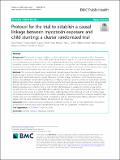Protocol for the trial to establish a causal linkage between mycotoxin exposure and child stunting: a cluster randomized trial.

View/
Date
2020-05-01Author
Phillips, Erica
Ngure, Francis
Smith, Laura
Makule, Edna
Turner, Paul
Nelson, Rebeca
Kimanya, Martin
Stoltzfus, Rebecca
Kassim, Neema
Metadata
Show full item recordAbstract
Background: The number of stunted children has fallen globally but continues to increase in Africa. Stunting is
estimated to contribute to 14–17% of child deaths under 5 years of age and is a risk factor for poor cognitive and
motor development and educational outcomes. Inadequate dietary intake and disease are thought to be the
immediate causes of undernutrition and stunting. However, improving infant diets through complementary feeding
interventions has been shown to only modestly reduce stunting. Multiple observational studies demonstrate a dose
response relationship between fetal and post-natal aflatoxin exposure and reduced linear growth.
Methods: This community-based cluster randomized trial will measure the effect of a reduced aflatoxin diet on
length-for-age Z scores at 18 months in central Tanzania. All 52 health facilities in the Kongwa District of Dodoma
Region were randomized into two groups. Starting at 6 months of age, participants in the intervention group
receive a low-aflatoxin pre-blended porridge flour containing maize and groundnut (ratio 4:1 respectively) and lowaflatoxin groundnut flour, whereas in the control group the same porridge mix and groundnut flour are promoted
through education but acquired by the household. Both groups will receive the same infant and young child
feeding education and a thermos flask. A total of 3120 infants between 6 weeks and 3 months of age will be
recruited into the study over 1 year. Data will be collected four times – at recruitment and when the infants are 6,
12 and 18 months of age. In a cohort of 600 infants, additional data will be collected at 9 and 15 months of age.
The primary outcome is length-for-age at 18 months. Secondary outcomes include the Z scores for weight-for-age,
middle upper arm circumference and head circumference, and the blood biomarker aflatoxin-albumin in the full
sample, with the urine biomarker aflatoxin M1 analyzed in the cohort only.
Discussion: Better understanding the etiology of childhood stunting can lead to more appropriate interventions
and policies to further reduce linear growth faltering and meet the Sustainable Development Goals
